Financial Analysis Report: Investment Strategy for Lunar Holdings
VerifiedAdded on 2022/10/01
|18
|4553
|71
Report
AI Summary
This report presents a comprehensive financial analysis of Lunar Holdings' proposed investment strategy. It begins by calculating and analyzing the expected returns and risks associated with investments in nanotechnology and battery development, using probability analysis and calculating variance, standard deviation, covariance, and correlation. The report then assesses the impact of the investment strategy on Lunar Holdings' overall risk, measured by standard deviation, and analyzes the effects on the company's beta value and cost of equity capital. A briefing paper for the CFO critically discusses the internal rate of return (IRR) and advocates for the use of a modified IRR (MIRR) analysis. Finally, the report addresses concerns regarding a rights issue, recommending the most suitable proposal for the company.
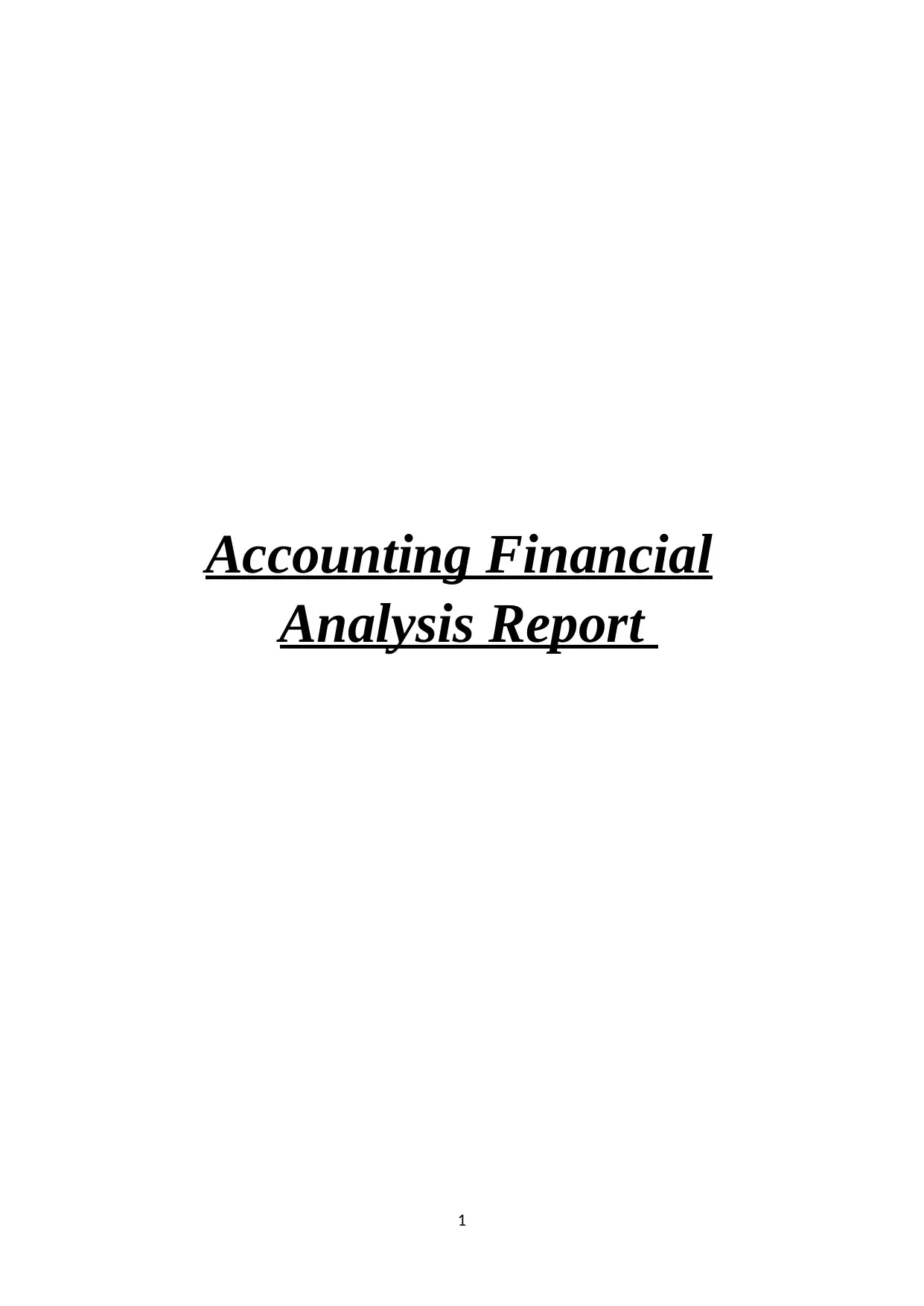
Accounting Financial
Analysis Report
1
Analysis Report
1
Paraphrase This Document
Need a fresh take? Get an instant paraphrase of this document with our AI Paraphraser
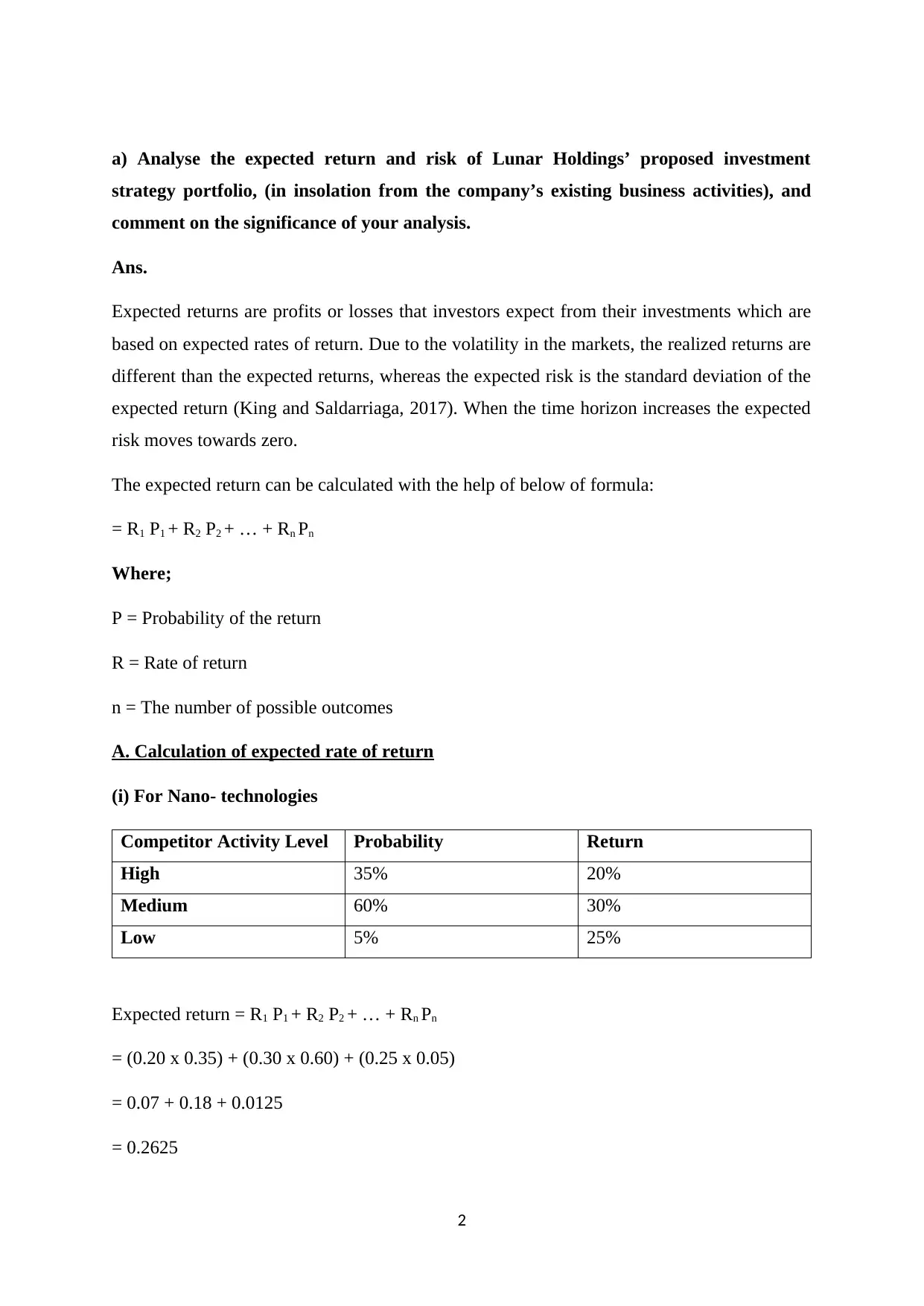
a) Analyse the expected return and risk of Lunar Holdings’ proposed investment
strategy portfolio, (in insolation from the company’s existing business activities), and
comment on the significance of your analysis.
Ans.
Expected returns are profits or losses that investors expect from their investments which are
based on expected rates of return. Due to the volatility in the markets, the realized returns are
different than the expected returns, whereas the expected risk is the standard deviation of the
expected return (King and Saldarriaga, 2017). When the time horizon increases the expected
risk moves towards zero.
The expected return can be calculated with the help of below of formula:
= R1 P1 + R2 P2 + … + Rn Pn
Where;
P = Probability of the return
R = Rate of return
n = The number of possible outcomes
A. Calculation of expected rate of return
(i) For Nano- technologies
Competitor Activity Level Probability Return
High 35% 20%
Medium 60% 30%
Low 5% 25%
Expected return = R1 P1 + R2 P2 + … + Rn Pn
= (0.20 x 0.35) + (0.30 x 0.60) + (0.25 x 0.05)
= 0.07 + 0.18 + 0.0125
= 0.2625
2
strategy portfolio, (in insolation from the company’s existing business activities), and
comment on the significance of your analysis.
Ans.
Expected returns are profits or losses that investors expect from their investments which are
based on expected rates of return. Due to the volatility in the markets, the realized returns are
different than the expected returns, whereas the expected risk is the standard deviation of the
expected return (King and Saldarriaga, 2017). When the time horizon increases the expected
risk moves towards zero.
The expected return can be calculated with the help of below of formula:
= R1 P1 + R2 P2 + … + Rn Pn
Where;
P = Probability of the return
R = Rate of return
n = The number of possible outcomes
A. Calculation of expected rate of return
(i) For Nano- technologies
Competitor Activity Level Probability Return
High 35% 20%
Medium 60% 30%
Low 5% 25%
Expected return = R1 P1 + R2 P2 + … + Rn Pn
= (0.20 x 0.35) + (0.30 x 0.60) + (0.25 x 0.05)
= 0.07 + 0.18 + 0.0125
= 0.2625
2
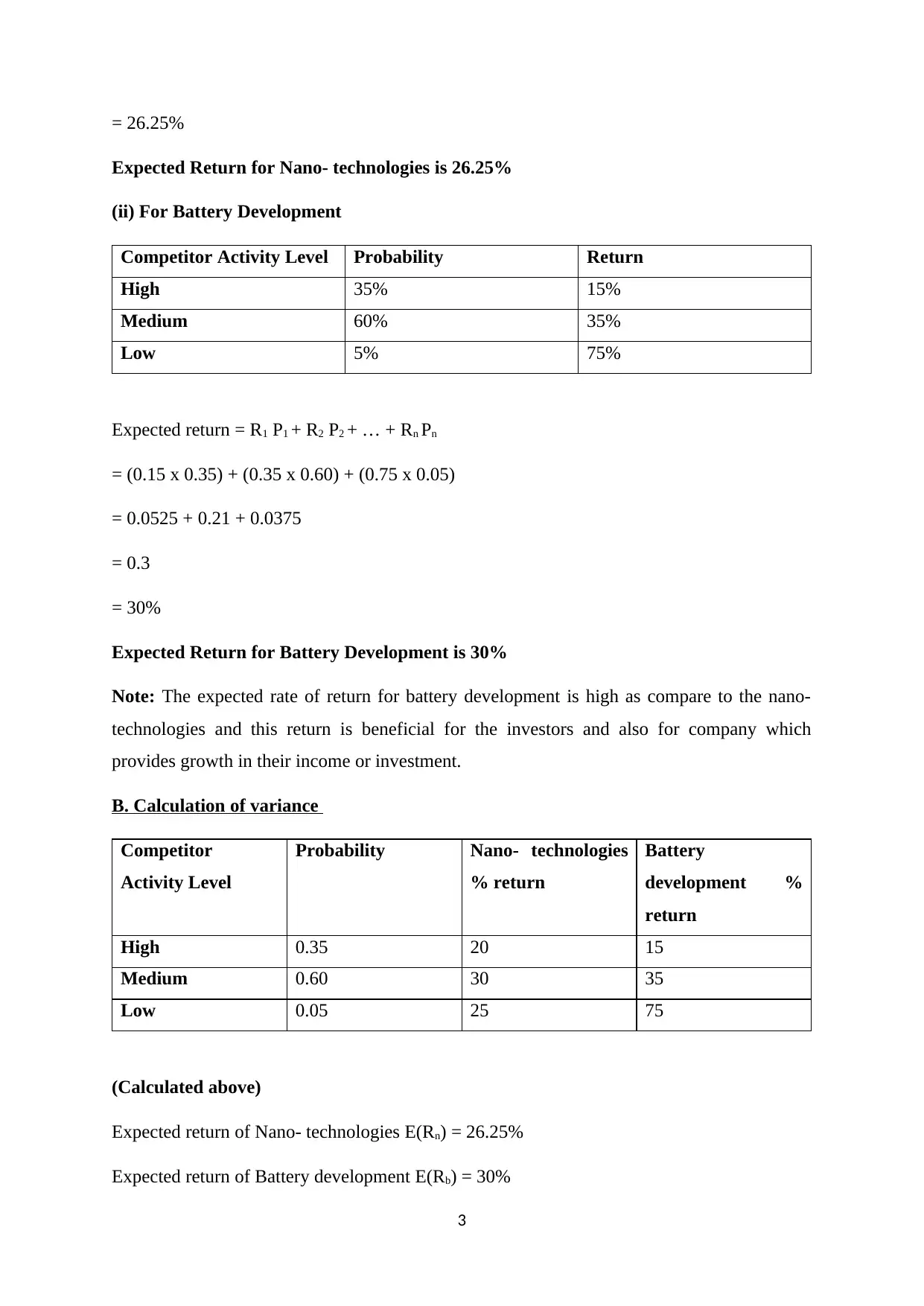
= 26.25%
Expected Return for Nano- technologies is 26.25%
(ii) For Battery Development
Competitor Activity Level Probability Return
High 35% 15%
Medium 60% 35%
Low 5% 75%
Expected return = R1 P1 + R2 P2 + … + Rn Pn
= (0.15 x 0.35) + (0.35 x 0.60) + (0.75 x 0.05)
= 0.0525 + 0.21 + 0.0375
= 0.3
= 30%
Expected Return for Battery Development is 30%
Note: The expected rate of return for battery development is high as compare to the nano-
technologies and this return is beneficial for the investors and also for company which
provides growth in their income or investment.
B. Calculation of variance
Competitor
Activity Level
Probability Nano- technologies
% return
Battery
development %
return
High 0.35 20 15
Medium 0.60 30 35
Low 0.05 25 75
(Calculated above)
Expected return of Nano- technologies E(Rn) = 26.25%
Expected return of Battery development E(Rb) = 30%
3
Expected Return for Nano- technologies is 26.25%
(ii) For Battery Development
Competitor Activity Level Probability Return
High 35% 15%
Medium 60% 35%
Low 5% 75%
Expected return = R1 P1 + R2 P2 + … + Rn Pn
= (0.15 x 0.35) + (0.35 x 0.60) + (0.75 x 0.05)
= 0.0525 + 0.21 + 0.0375
= 0.3
= 30%
Expected Return for Battery Development is 30%
Note: The expected rate of return for battery development is high as compare to the nano-
technologies and this return is beneficial for the investors and also for company which
provides growth in their income or investment.
B. Calculation of variance
Competitor
Activity Level
Probability Nano- technologies
% return
Battery
development %
return
High 0.35 20 15
Medium 0.60 30 35
Low 0.05 25 75
(Calculated above)
Expected return of Nano- technologies E(Rn) = 26.25%
Expected return of Battery development E(Rb) = 30%
3
⊘ This is a preview!⊘
Do you want full access?
Subscribe today to unlock all pages.

Trusted by 1+ million students worldwide
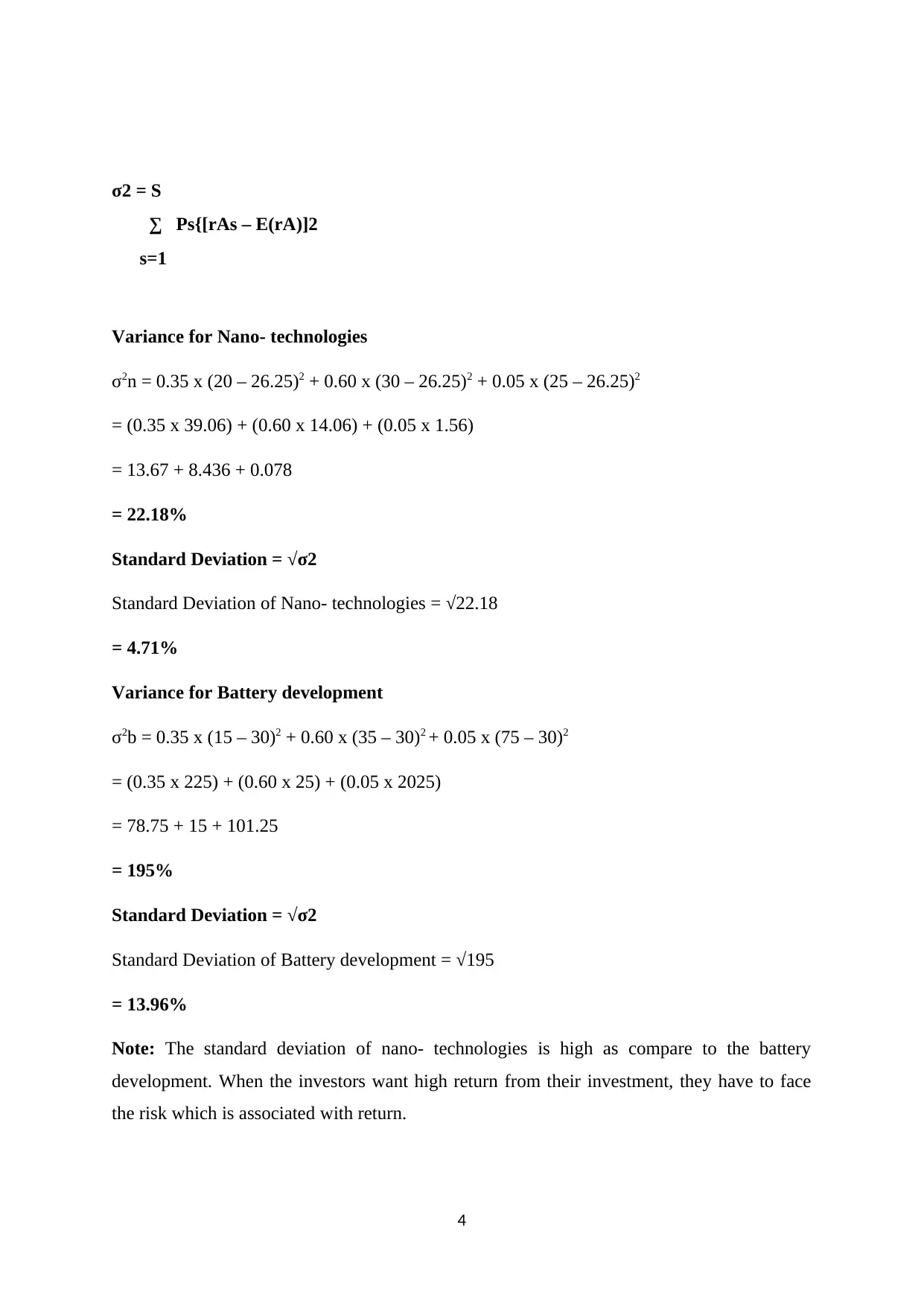
σ2 = S
∑ Ps{[rAs – E(rA)]2
s=1
Variance for Nano- technologies
σ2n = 0.35 x (20 – 26.25)2 + 0.60 x (30 – 26.25)2 + 0.05 x (25 – 26.25)2
= (0.35 x 39.06) + (0.60 x 14.06) + (0.05 x 1.56)
= 13.67 + 8.436 + 0.078
= 22.18%
Standard Deviation = √σ2
Standard Deviation of Nano- technologies = √22.18
= 4.71%
Variance for Battery development
σ2b = 0.35 x (15 – 30)2 + 0.60 x (35 – 30)2 + 0.05 x (75 – 30)2
= (0.35 x 225) + (0.60 x 25) + (0.05 x 2025)
= 78.75 + 15 + 101.25
= 195%
Standard Deviation = √σ2
Standard Deviation of Battery development = √195
= 13.96%
Note: The standard deviation of nano- technologies is high as compare to the battery
development. When the investors want high return from their investment, they have to face
the risk which is associated with return.
4
∑ Ps{[rAs – E(rA)]2
s=1
Variance for Nano- technologies
σ2n = 0.35 x (20 – 26.25)2 + 0.60 x (30 – 26.25)2 + 0.05 x (25 – 26.25)2
= (0.35 x 39.06) + (0.60 x 14.06) + (0.05 x 1.56)
= 13.67 + 8.436 + 0.078
= 22.18%
Standard Deviation = √σ2
Standard Deviation of Nano- technologies = √22.18
= 4.71%
Variance for Battery development
σ2b = 0.35 x (15 – 30)2 + 0.60 x (35 – 30)2 + 0.05 x (75 – 30)2
= (0.35 x 225) + (0.60 x 25) + (0.05 x 2025)
= 78.75 + 15 + 101.25
= 195%
Standard Deviation = √σ2
Standard Deviation of Battery development = √195
= 13.96%
Note: The standard deviation of nano- technologies is high as compare to the battery
development. When the investors want high return from their investment, they have to face
the risk which is associated with return.
4
Paraphrase This Document
Need a fresh take? Get an instant paraphrase of this document with our AI Paraphraser
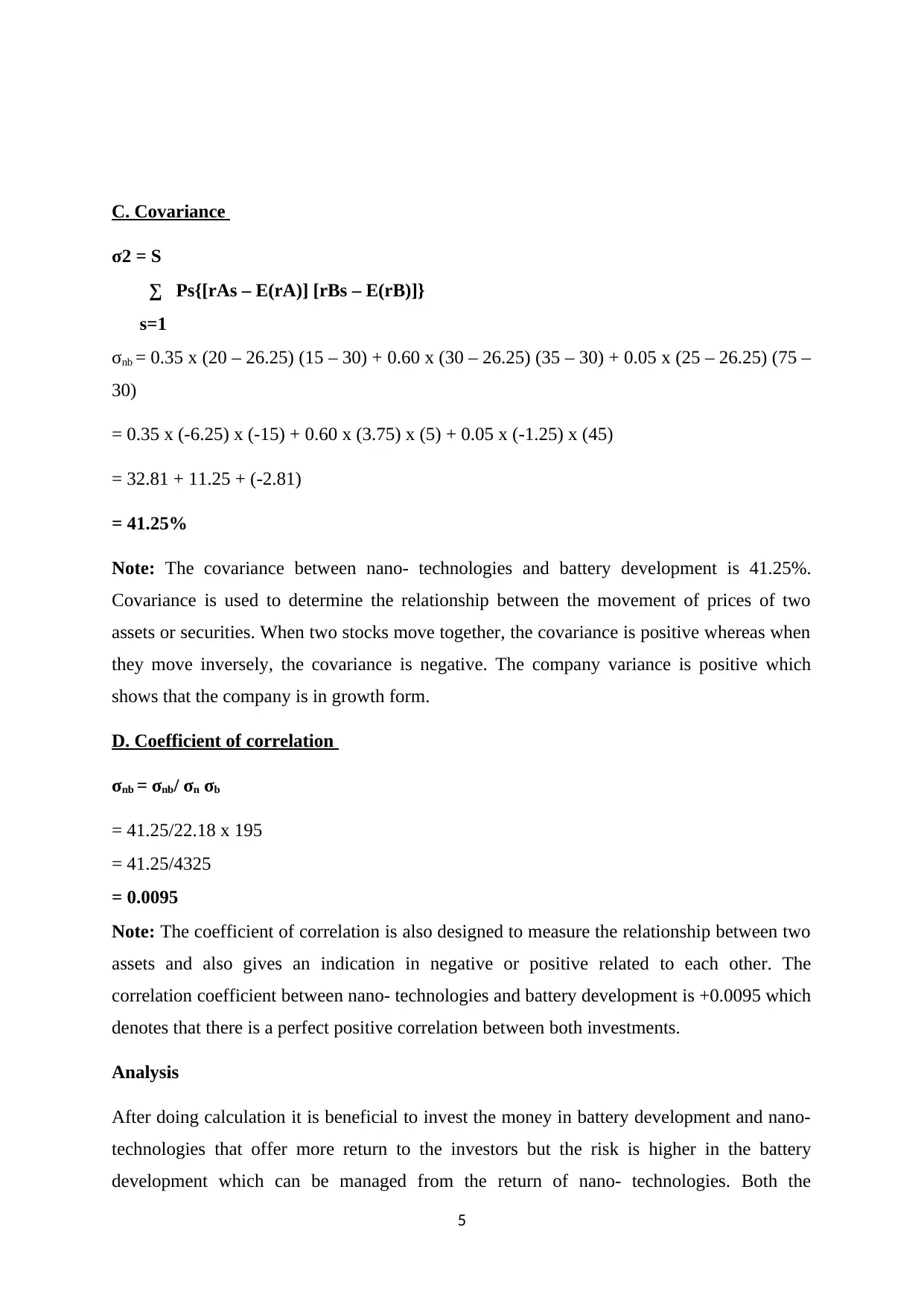
C. Covariance
σ2 = S
∑ Ps{[rAs – E(rA)] [rBs – E(rB)]}
s=1
σnb = 0.35 x (20 – 26.25) (15 – 30) + 0.60 x (30 – 26.25) (35 – 30) + 0.05 x (25 – 26.25) (75 –
30)
= 0.35 x (-6.25) x (-15) + 0.60 x (3.75) x (5) + 0.05 x (-1.25) x (45)
= 32.81 + 11.25 + (-2.81)
= 41.25%
Note: The covariance between nano- technologies and battery development is 41.25%.
Covariance is used to determine the relationship between the movement of prices of two
assets or securities. When two stocks move together, the covariance is positive whereas when
they move inversely, the covariance is negative. The company variance is positive which
shows that the company is in growth form.
D. Coefficient of correlation
σnb = σnb/ σn σb
= 41.25/22.18 x 195
= 41.25/4325
= 0.0095
Note: The coefficient of correlation is also designed to measure the relationship between two
assets and also gives an indication in negative or positive related to each other. The
correlation coefficient between nano- technologies and battery development is +0.0095 which
denotes that there is a perfect positive correlation between both investments.
Analysis
After doing calculation it is beneficial to invest the money in battery development and nano-
technologies that offer more return to the investors but the risk is higher in the battery
development which can be managed from the return of nano- technologies. Both the
5
σ2 = S
∑ Ps{[rAs – E(rA)] [rBs – E(rB)]}
s=1
σnb = 0.35 x (20 – 26.25) (15 – 30) + 0.60 x (30 – 26.25) (35 – 30) + 0.05 x (25 – 26.25) (75 –
30)
= 0.35 x (-6.25) x (-15) + 0.60 x (3.75) x (5) + 0.05 x (-1.25) x (45)
= 32.81 + 11.25 + (-2.81)
= 41.25%
Note: The covariance between nano- technologies and battery development is 41.25%.
Covariance is used to determine the relationship between the movement of prices of two
assets or securities. When two stocks move together, the covariance is positive whereas when
they move inversely, the covariance is negative. The company variance is positive which
shows that the company is in growth form.
D. Coefficient of correlation
σnb = σnb/ σn σb
= 41.25/22.18 x 195
= 41.25/4325
= 0.0095
Note: The coefficient of correlation is also designed to measure the relationship between two
assets and also gives an indication in negative or positive related to each other. The
correlation coefficient between nano- technologies and battery development is +0.0095 which
denotes that there is a perfect positive correlation between both investments.
Analysis
After doing calculation it is beneficial to invest the money in battery development and nano-
technologies that offer more return to the investors but the risk is higher in the battery
development which can be managed from the return of nano- technologies. Both the
5
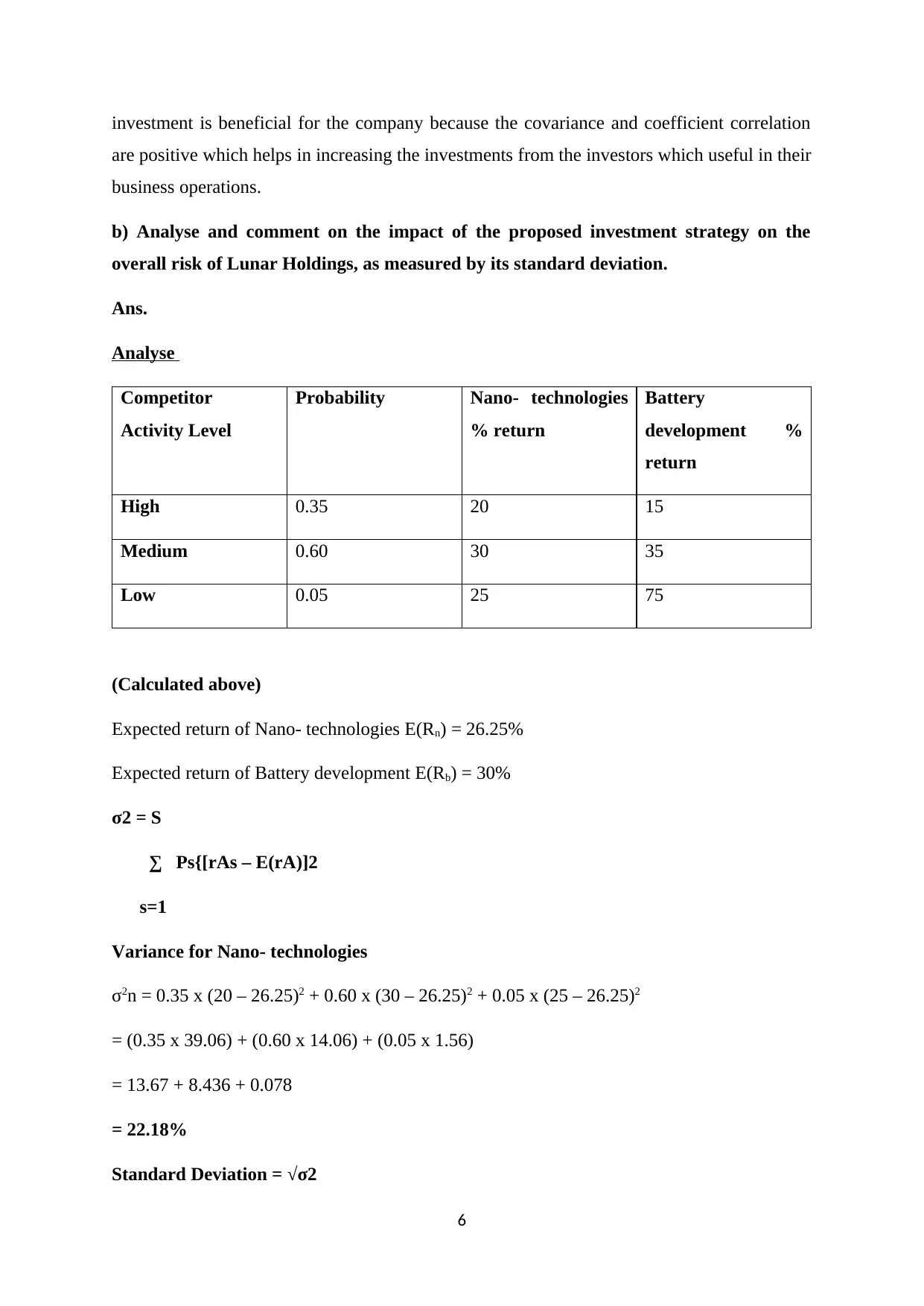
investment is beneficial for the company because the covariance and coefficient correlation
are positive which helps in increasing the investments from the investors which useful in their
business operations.
b) Analyse and comment on the impact of the proposed investment strategy on the
overall risk of Lunar Holdings, as measured by its standard deviation.
Ans.
Analyse
Competitor
Activity Level
Probability Nano- technologies
% return
Battery
development %
return
High 0.35 20 15
Medium 0.60 30 35
Low 0.05 25 75
(Calculated above)
Expected return of Nano- technologies E(Rn) = 26.25%
Expected return of Battery development E(Rb) = 30%
σ2 = S
∑ Ps{[rAs – E(rA)]2
s=1
Variance for Nano- technologies
σ2n = 0.35 x (20 – 26.25)2 + 0.60 x (30 – 26.25)2 + 0.05 x (25 – 26.25)2
= (0.35 x 39.06) + (0.60 x 14.06) + (0.05 x 1.56)
= 13.67 + 8.436 + 0.078
= 22.18%
Standard Deviation = √σ2
6
are positive which helps in increasing the investments from the investors which useful in their
business operations.
b) Analyse and comment on the impact of the proposed investment strategy on the
overall risk of Lunar Holdings, as measured by its standard deviation.
Ans.
Analyse
Competitor
Activity Level
Probability Nano- technologies
% return
Battery
development %
return
High 0.35 20 15
Medium 0.60 30 35
Low 0.05 25 75
(Calculated above)
Expected return of Nano- technologies E(Rn) = 26.25%
Expected return of Battery development E(Rb) = 30%
σ2 = S
∑ Ps{[rAs – E(rA)]2
s=1
Variance for Nano- technologies
σ2n = 0.35 x (20 – 26.25)2 + 0.60 x (30 – 26.25)2 + 0.05 x (25 – 26.25)2
= (0.35 x 39.06) + (0.60 x 14.06) + (0.05 x 1.56)
= 13.67 + 8.436 + 0.078
= 22.18%
Standard Deviation = √σ2
6
⊘ This is a preview!⊘
Do you want full access?
Subscribe today to unlock all pages.

Trusted by 1+ million students worldwide
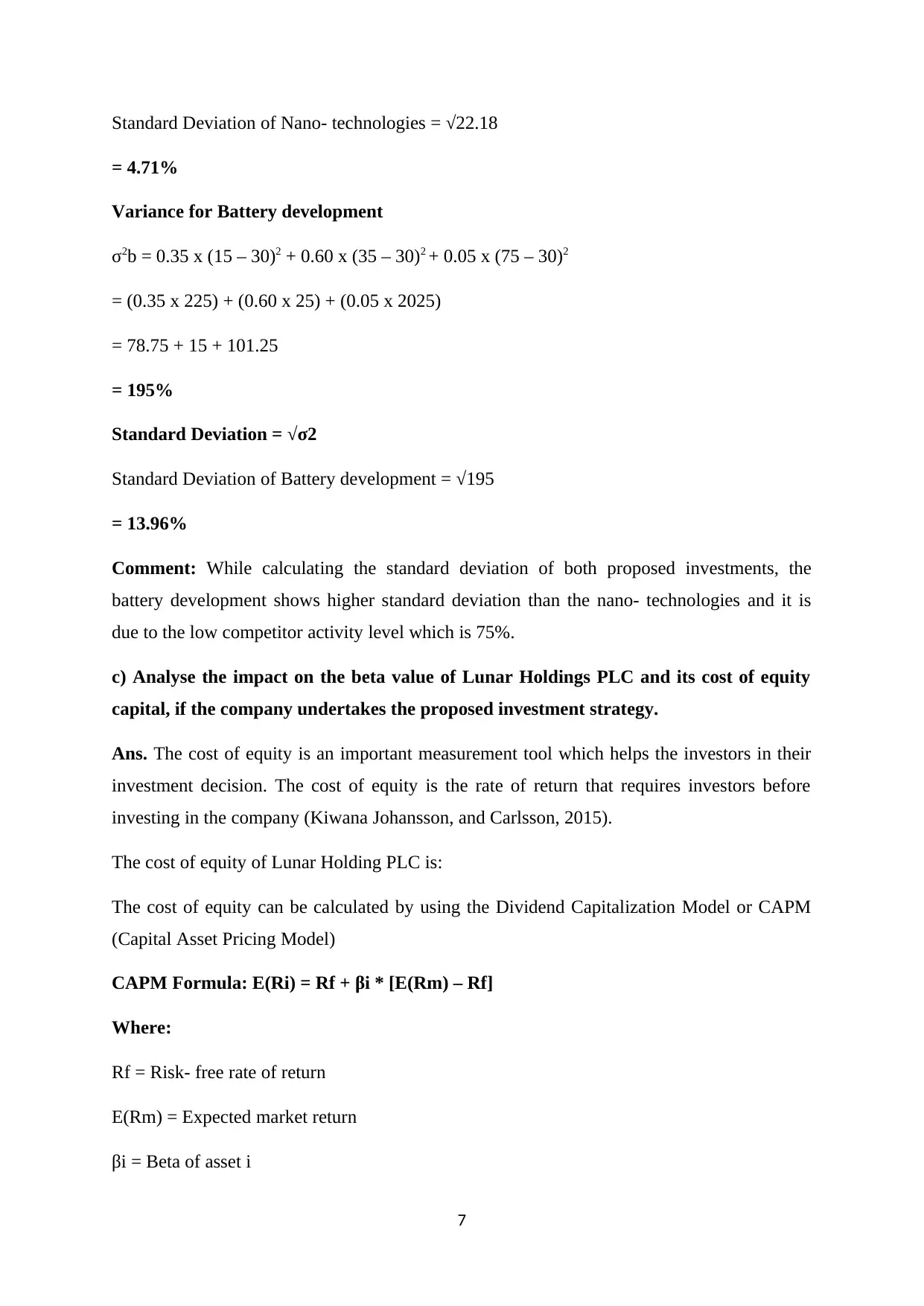
Standard Deviation of Nano- technologies = √22.18
= 4.71%
Variance for Battery development
σ2b = 0.35 x (15 – 30)2 + 0.60 x (35 – 30)2 + 0.05 x (75 – 30)2
= (0.35 x 225) + (0.60 x 25) + (0.05 x 2025)
= 78.75 + 15 + 101.25
= 195%
Standard Deviation = √σ2
Standard Deviation of Battery development = √195
= 13.96%
Comment: While calculating the standard deviation of both proposed investments, the
battery development shows higher standard deviation than the nano- technologies and it is
due to the low competitor activity level which is 75%.
c) Analyse the impact on the beta value of Lunar Holdings PLC and its cost of equity
capital, if the company undertakes the proposed investment strategy.
Ans. The cost of equity is an important measurement tool which helps the investors in their
investment decision. The cost of equity is the rate of return that requires investors before
investing in the company (Kiwana Johansson, and Carlsson, 2015).
The cost of equity of Lunar Holding PLC is:
The cost of equity can be calculated by using the Dividend Capitalization Model or CAPM
(Capital Asset Pricing Model)
CAPM Formula: E(Ri) = Rf + βi * [E(Rm) – Rf]
Where:
Rf = Risk- free rate of return
E(Rm) = Expected market return
βi = Beta of asset i
7
= 4.71%
Variance for Battery development
σ2b = 0.35 x (15 – 30)2 + 0.60 x (35 – 30)2 + 0.05 x (75 – 30)2
= (0.35 x 225) + (0.60 x 25) + (0.05 x 2025)
= 78.75 + 15 + 101.25
= 195%
Standard Deviation = √σ2
Standard Deviation of Battery development = √195
= 13.96%
Comment: While calculating the standard deviation of both proposed investments, the
battery development shows higher standard deviation than the nano- technologies and it is
due to the low competitor activity level which is 75%.
c) Analyse the impact on the beta value of Lunar Holdings PLC and its cost of equity
capital, if the company undertakes the proposed investment strategy.
Ans. The cost of equity is an important measurement tool which helps the investors in their
investment decision. The cost of equity is the rate of return that requires investors before
investing in the company (Kiwana Johansson, and Carlsson, 2015).
The cost of equity of Lunar Holding PLC is:
The cost of equity can be calculated by using the Dividend Capitalization Model or CAPM
(Capital Asset Pricing Model)
CAPM Formula: E(Ri) = Rf + βi * [E(Rm) – Rf]
Where:
Rf = Risk- free rate of return
E(Rm) = Expected market return
βi = Beta of asset i
7
Paraphrase This Document
Need a fresh take? Get an instant paraphrase of this document with our AI Paraphraser
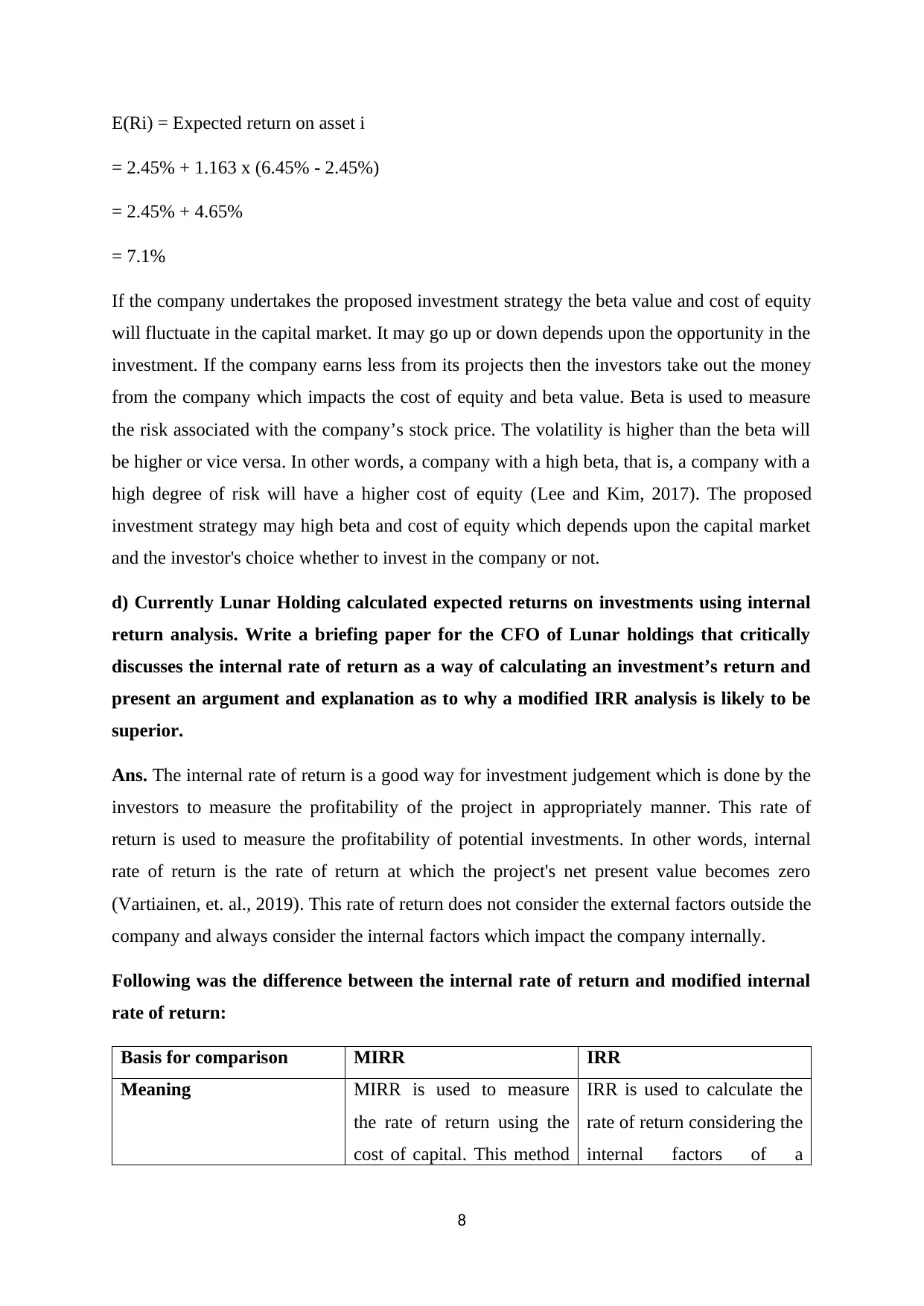
E(Ri) = Expected return on asset i
= 2.45% + 1.163 x (6.45% - 2.45%)
= 2.45% + 4.65%
= 7.1%
If the company undertakes the proposed investment strategy the beta value and cost of equity
will fluctuate in the capital market. It may go up or down depends upon the opportunity in the
investment. If the company earns less from its projects then the investors take out the money
from the company which impacts the cost of equity and beta value. Beta is used to measure
the risk associated with the company’s stock price. The volatility is higher than the beta will
be higher or vice versa. In other words, a company with a high beta, that is, a company with a
high degree of risk will have a higher cost of equity (Lee and Kim, 2017). The proposed
investment strategy may high beta and cost of equity which depends upon the capital market
and the investor's choice whether to invest in the company or not.
d) Currently Lunar Holding calculated expected returns on investments using internal
return analysis. Write a briefing paper for the CFO of Lunar holdings that critically
discusses the internal rate of return as a way of calculating an investment’s return and
present an argument and explanation as to why a modified IRR analysis is likely to be
superior.
Ans. The internal rate of return is a good way for investment judgement which is done by the
investors to measure the profitability of the project in appropriately manner. This rate of
return is used to measure the profitability of potential investments. In other words, internal
rate of return is the rate of return at which the project's net present value becomes zero
(Vartiainen, et. al., 2019). This rate of return does not consider the external factors outside the
company and always consider the internal factors which impact the company internally.
Following was the difference between the internal rate of return and modified internal
rate of return:
Basis for comparison MIRR IRR
Meaning MIRR is used to measure
the rate of return using the
cost of capital. This method
IRR is used to calculate the
rate of return considering the
internal factors of a
8
= 2.45% + 1.163 x (6.45% - 2.45%)
= 2.45% + 4.65%
= 7.1%
If the company undertakes the proposed investment strategy the beta value and cost of equity
will fluctuate in the capital market. It may go up or down depends upon the opportunity in the
investment. If the company earns less from its projects then the investors take out the money
from the company which impacts the cost of equity and beta value. Beta is used to measure
the risk associated with the company’s stock price. The volatility is higher than the beta will
be higher or vice versa. In other words, a company with a high beta, that is, a company with a
high degree of risk will have a higher cost of equity (Lee and Kim, 2017). The proposed
investment strategy may high beta and cost of equity which depends upon the capital market
and the investor's choice whether to invest in the company or not.
d) Currently Lunar Holding calculated expected returns on investments using internal
return analysis. Write a briefing paper for the CFO of Lunar holdings that critically
discusses the internal rate of return as a way of calculating an investment’s return and
present an argument and explanation as to why a modified IRR analysis is likely to be
superior.
Ans. The internal rate of return is a good way for investment judgement which is done by the
investors to measure the profitability of the project in appropriately manner. This rate of
return is used to measure the profitability of potential investments. In other words, internal
rate of return is the rate of return at which the project's net present value becomes zero
(Vartiainen, et. al., 2019). This rate of return does not consider the external factors outside the
company and always consider the internal factors which impact the company internally.
Following was the difference between the internal rate of return and modified internal
rate of return:
Basis for comparison MIRR IRR
Meaning MIRR is used to measure
the rate of return using the
cost of capital. This method
IRR is used to calculate the
rate of return considering the
internal factors of a
8
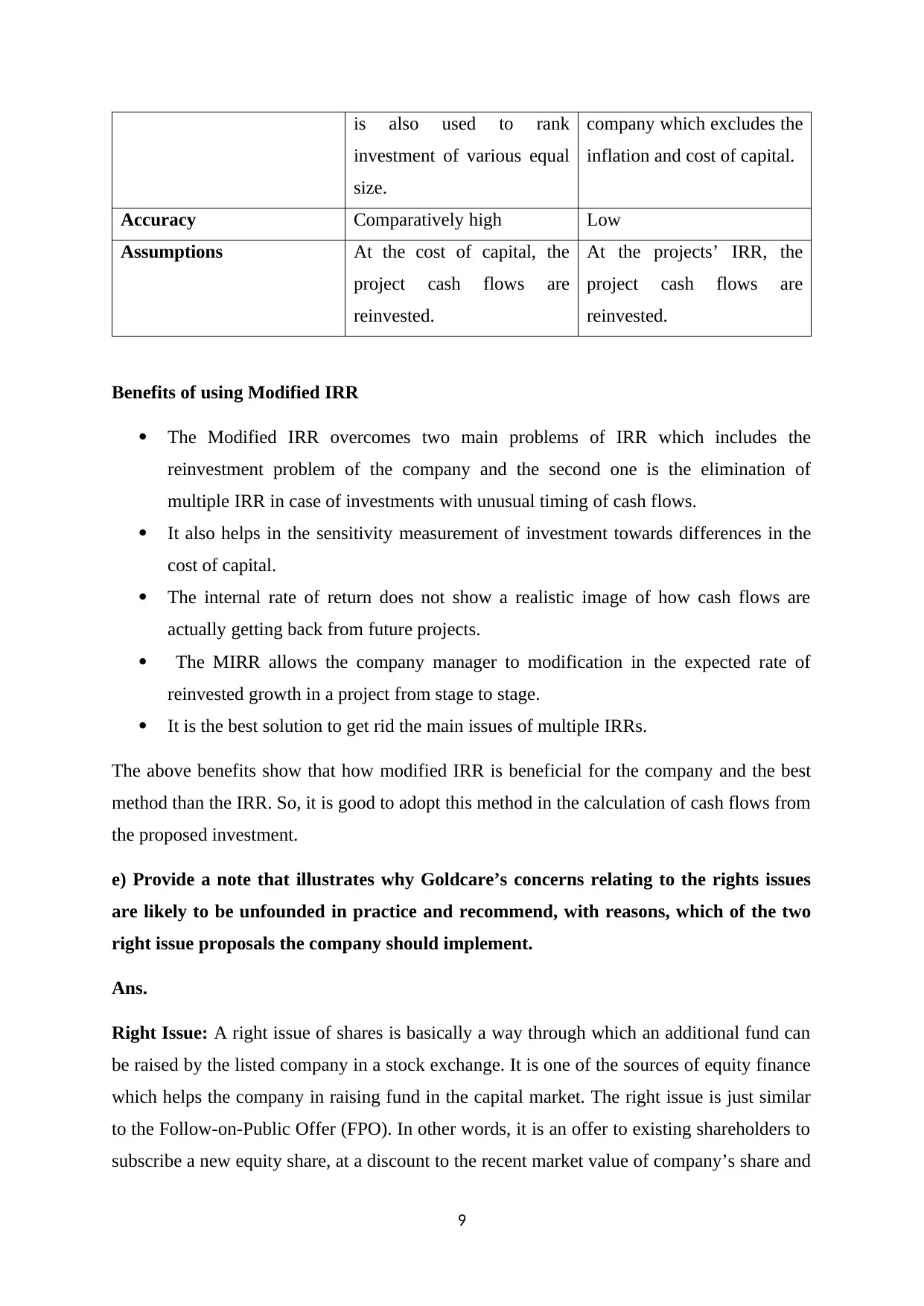
is also used to rank
investment of various equal
size.
company which excludes the
inflation and cost of capital.
Accuracy Comparatively high Low
Assumptions At the cost of capital, the
project cash flows are
reinvested.
At the projects’ IRR, the
project cash flows are
reinvested.
Benefits of using Modified IRR
The Modified IRR overcomes two main problems of IRR which includes the
reinvestment problem of the company and the second one is the elimination of
multiple IRR in case of investments with unusual timing of cash flows.
It also helps in the sensitivity measurement of investment towards differences in the
cost of capital.
The internal rate of return does not show a realistic image of how cash flows are
actually getting back from future projects.
The MIRR allows the company manager to modification in the expected rate of
reinvested growth in a project from stage to stage.
It is the best solution to get rid the main issues of multiple IRRs.
The above benefits show that how modified IRR is beneficial for the company and the best
method than the IRR. So, it is good to adopt this method in the calculation of cash flows from
the proposed investment.
e) Provide a note that illustrates why Goldcare’s concerns relating to the rights issues
are likely to be unfounded in practice and recommend, with reasons, which of the two
right issue proposals the company should implement.
Ans.
Right Issue: A right issue of shares is basically a way through which an additional fund can
be raised by the listed company in a stock exchange. It is one of the sources of equity finance
which helps the company in raising fund in the capital market. The right issue is just similar
to the Follow-on-Public Offer (FPO). In other words, it is an offer to existing shareholders to
subscribe a new equity share, at a discount to the recent market value of company’s share and
9
investment of various equal
size.
company which excludes the
inflation and cost of capital.
Accuracy Comparatively high Low
Assumptions At the cost of capital, the
project cash flows are
reinvested.
At the projects’ IRR, the
project cash flows are
reinvested.
Benefits of using Modified IRR
The Modified IRR overcomes two main problems of IRR which includes the
reinvestment problem of the company and the second one is the elimination of
multiple IRR in case of investments with unusual timing of cash flows.
It also helps in the sensitivity measurement of investment towards differences in the
cost of capital.
The internal rate of return does not show a realistic image of how cash flows are
actually getting back from future projects.
The MIRR allows the company manager to modification in the expected rate of
reinvested growth in a project from stage to stage.
It is the best solution to get rid the main issues of multiple IRRs.
The above benefits show that how modified IRR is beneficial for the company and the best
method than the IRR. So, it is good to adopt this method in the calculation of cash flows from
the proposed investment.
e) Provide a note that illustrates why Goldcare’s concerns relating to the rights issues
are likely to be unfounded in practice and recommend, with reasons, which of the two
right issue proposals the company should implement.
Ans.
Right Issue: A right issue of shares is basically a way through which an additional fund can
be raised by the listed company in a stock exchange. It is one of the sources of equity finance
which helps the company in raising fund in the capital market. The right issue is just similar
to the Follow-on-Public Offer (FPO). In other words, it is an offer to existing shareholders to
subscribe a new equity share, at a discount to the recent market value of company’s share and
9
⊘ This is a preview!⊘
Do you want full access?
Subscribe today to unlock all pages.

Trusted by 1+ million students worldwide
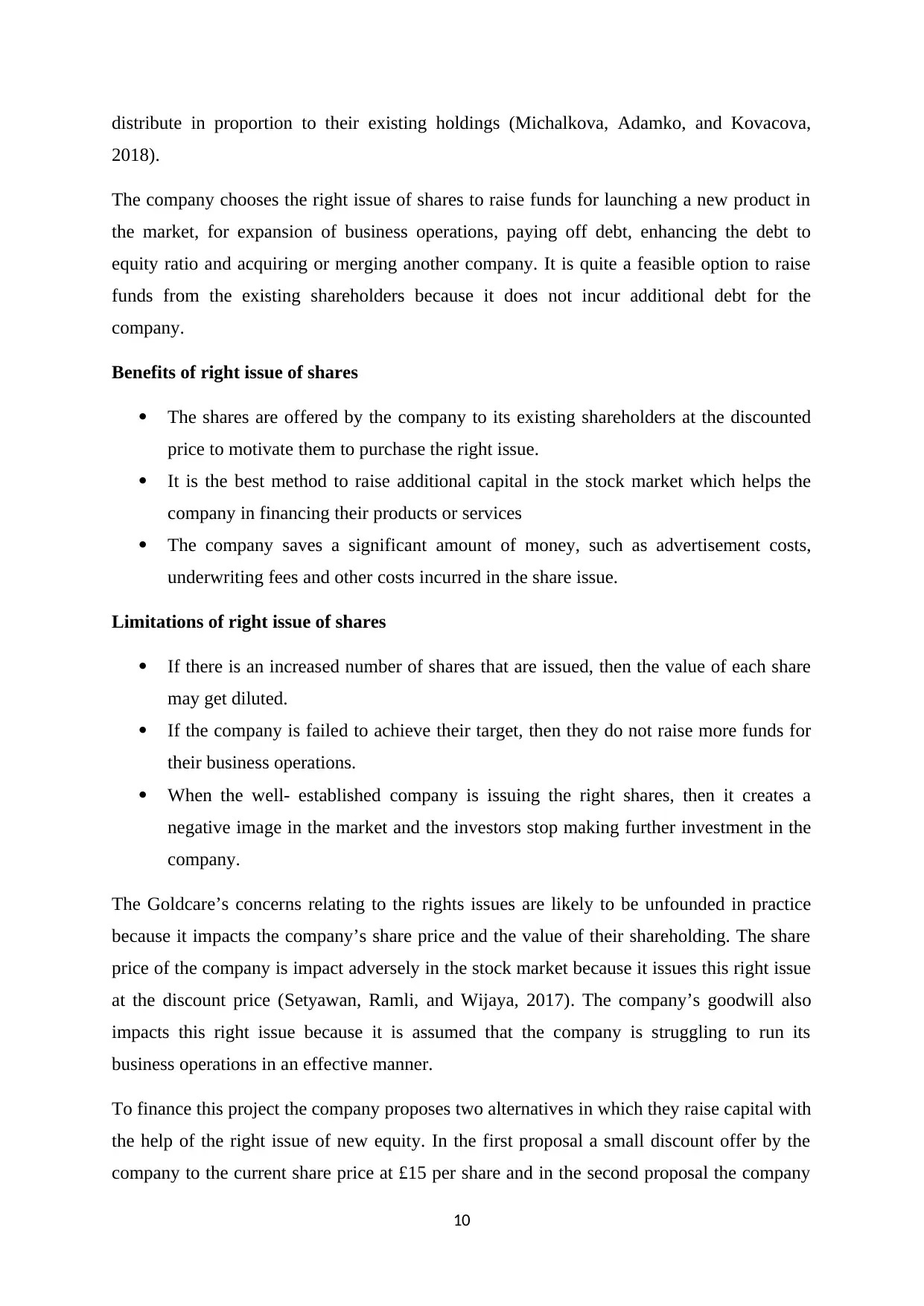
distribute in proportion to their existing holdings (Michalkova, Adamko, and Kovacova,
2018).
The company chooses the right issue of shares to raise funds for launching a new product in
the market, for expansion of business operations, paying off debt, enhancing the debt to
equity ratio and acquiring or merging another company. It is quite a feasible option to raise
funds from the existing shareholders because it does not incur additional debt for the
company.
Benefits of right issue of shares
The shares are offered by the company to its existing shareholders at the discounted
price to motivate them to purchase the right issue.
It is the best method to raise additional capital in the stock market which helps the
company in financing their products or services
The company saves a significant amount of money, such as advertisement costs,
underwriting fees and other costs incurred in the share issue.
Limitations of right issue of shares
If there is an increased number of shares that are issued, then the value of each share
may get diluted.
If the company is failed to achieve their target, then they do not raise more funds for
their business operations.
When the well- established company is issuing the right shares, then it creates a
negative image in the market and the investors stop making further investment in the
company.
The Goldcare’s concerns relating to the rights issues are likely to be unfounded in practice
because it impacts the company’s share price and the value of their shareholding. The share
price of the company is impact adversely in the stock market because it issues this right issue
at the discount price (Setyawan, Ramli, and Wijaya, 2017). The company’s goodwill also
impacts this right issue because it is assumed that the company is struggling to run its
business operations in an effective manner.
To finance this project the company proposes two alternatives in which they raise capital with
the help of the right issue of new equity. In the first proposal a small discount offer by the
company to the current share price at £15 per share and in the second proposal the company
10
2018).
The company chooses the right issue of shares to raise funds for launching a new product in
the market, for expansion of business operations, paying off debt, enhancing the debt to
equity ratio and acquiring or merging another company. It is quite a feasible option to raise
funds from the existing shareholders because it does not incur additional debt for the
company.
Benefits of right issue of shares
The shares are offered by the company to its existing shareholders at the discounted
price to motivate them to purchase the right issue.
It is the best method to raise additional capital in the stock market which helps the
company in financing their products or services
The company saves a significant amount of money, such as advertisement costs,
underwriting fees and other costs incurred in the share issue.
Limitations of right issue of shares
If there is an increased number of shares that are issued, then the value of each share
may get diluted.
If the company is failed to achieve their target, then they do not raise more funds for
their business operations.
When the well- established company is issuing the right shares, then it creates a
negative image in the market and the investors stop making further investment in the
company.
The Goldcare’s concerns relating to the rights issues are likely to be unfounded in practice
because it impacts the company’s share price and the value of their shareholding. The share
price of the company is impact adversely in the stock market because it issues this right issue
at the discount price (Setyawan, Ramli, and Wijaya, 2017). The company’s goodwill also
impacts this right issue because it is assumed that the company is struggling to run its
business operations in an effective manner.
To finance this project the company proposes two alternatives in which they raise capital with
the help of the right issue of new equity. In the first proposal a small discount offer by the
company to the current share price at £15 per share and in the second proposal the company
10
Paraphrase This Document
Need a fresh take? Get an instant paraphrase of this document with our AI Paraphraser

offers a deeper discount to the current share price at £10 per share (Saad, et. al., 2019). If the
company wants to raise the capital with the help of right issue than it is better to opt first
proposal to issue this share at £15 per share. The first proposal is beneficial for the company.
11
company wants to raise the capital with the help of right issue than it is better to opt first
proposal to issue this share at £15 per share. The first proposal is beneficial for the company.
11
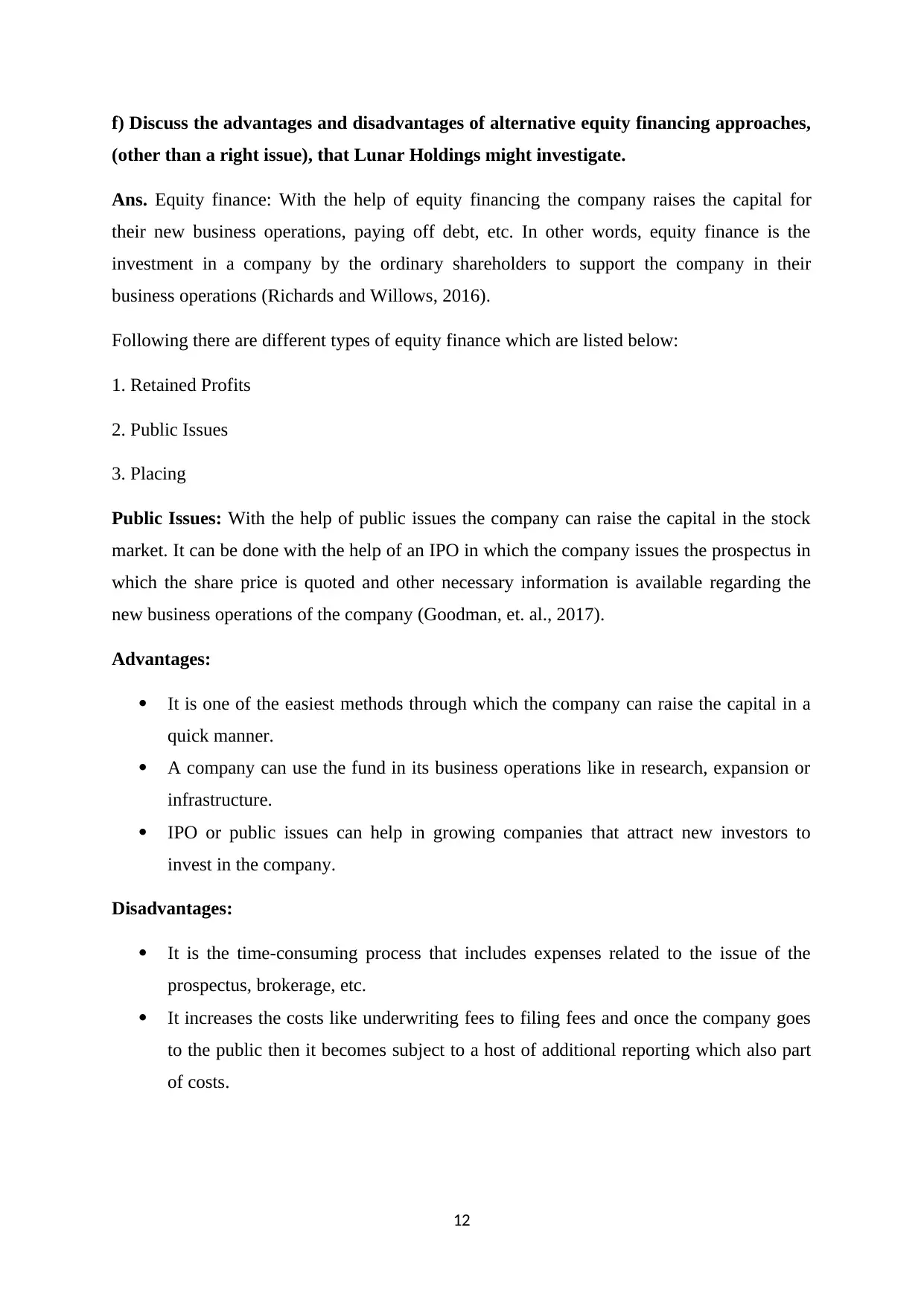
f) Discuss the advantages and disadvantages of alternative equity financing approaches,
(other than a right issue), that Lunar Holdings might investigate.
Ans. Equity finance: With the help of equity financing the company raises the capital for
their new business operations, paying off debt, etc. In other words, equity finance is the
investment in a company by the ordinary shareholders to support the company in their
business operations (Richards and Willows, 2016).
Following there are different types of equity finance which are listed below:
1. Retained Profits
2. Public Issues
3. Placing
Public Issues: With the help of public issues the company can raise the capital in the stock
market. It can be done with the help of an IPO in which the company issues the prospectus in
which the share price is quoted and other necessary information is available regarding the
new business operations of the company (Goodman, et. al., 2017).
Advantages:
It is one of the easiest methods through which the company can raise the capital in a
quick manner.
A company can use the fund in its business operations like in research, expansion or
infrastructure.
IPO or public issues can help in growing companies that attract new investors to
invest in the company.
Disadvantages:
It is the time-consuming process that includes expenses related to the issue of the
prospectus, brokerage, etc.
It increases the costs like underwriting fees to filing fees and once the company goes
to the public then it becomes subject to a host of additional reporting which also part
of costs.
12
(other than a right issue), that Lunar Holdings might investigate.
Ans. Equity finance: With the help of equity financing the company raises the capital for
their new business operations, paying off debt, etc. In other words, equity finance is the
investment in a company by the ordinary shareholders to support the company in their
business operations (Richards and Willows, 2016).
Following there are different types of equity finance which are listed below:
1. Retained Profits
2. Public Issues
3. Placing
Public Issues: With the help of public issues the company can raise the capital in the stock
market. It can be done with the help of an IPO in which the company issues the prospectus in
which the share price is quoted and other necessary information is available regarding the
new business operations of the company (Goodman, et. al., 2017).
Advantages:
It is one of the easiest methods through which the company can raise the capital in a
quick manner.
A company can use the fund in its business operations like in research, expansion or
infrastructure.
IPO or public issues can help in growing companies that attract new investors to
invest in the company.
Disadvantages:
It is the time-consuming process that includes expenses related to the issue of the
prospectus, brokerage, etc.
It increases the costs like underwriting fees to filing fees and once the company goes
to the public then it becomes subject to a host of additional reporting which also part
of costs.
12
⊘ This is a preview!⊘
Do you want full access?
Subscribe today to unlock all pages.

Trusted by 1+ million students worldwide
1 out of 18
Your All-in-One AI-Powered Toolkit for Academic Success.
+13062052269
info@desklib.com
Available 24*7 on WhatsApp / Email
![[object Object]](/_next/static/media/star-bottom.7253800d.svg)
Unlock your academic potential
Copyright © 2020–2025 A2Z Services. All Rights Reserved. Developed and managed by ZUCOL.